The hallowed halls of the Academy of Applied Filmi Snake Research and Ethics are buzzing with the latest controversy. Our visiting snake expert responds to the (unfair, unjust and unreasonable) criticism levelled at her work by an anonymous weasel professor.
Professor,
I am gratified that you have provided the opportunity for further discourse and academic debate in response to the Filmi Snake Spotter’s Field Guide (The Guide) in your comment about Beth’s scholarly analysis of the snake film Naag Lok. Before I provide some additional comments in relation to the criticisms levelled at my work, I would also like to acknowledge the contribution of Beth (Illinois, 2011) to the evidence base of filmi snake identification. As you noted, the principles of scientific rigour to which she has adhered, are laudable and set a new standard in the field.
Whilst Beth (ibid) has certainly identified two new areas for research in the roles of the transformative snake skin lens overlay and the serpentine tikka, I would like to draw your attention to some comments in the introductory section of The Guide: (a.) “In this guide we will illustrate only a small sample of the many hundreds of filmi snake species featured in sub continental movies” (p. 1.) and (b.) “Although scientific validation has been undertaken through consultation with both acknowledged experts and enthusiastic amateurs in the area, hypotheses are always subject to revision with an expanded evidence base.”
It is important, I believe, to acknowledge the audience for whom one is writing. Whilst perhaps it can be argued that the scope of The Guide is broad, as explicitly stated, the intention was the provide some basic, yet practically helpful information, thus providing some guidelines and structure for filmi snake identification, for both professionals and lay persons alike. At no point, I would like to emphasise, was The Guide touted as an exhaustive monograph.
I would specifically like to address the assertion that omissions of reference were made to the characteristic of venom and the role of the mongoose in filmi snake identification.
1. Venom
Far from neglecting the role of venom in filmi identification, it is important to note that the results in this area are sufficiently inconclusive at this stage, for exclusion from The Guide.
The sample at the current time is simply too small to achieve any acceptable level of statistical significance. Observational data suggests that venom may be a useful indicator, but we have conflicting information about both the impact of gender on venom, as well as some conflicting data about colour of venom (though it appears that venom is on the colour spectrum of clear to blue-violet). The two things that the data demonstrates as emerging trends are (i) that all bodily fluids of the filmi snake appear to be venomous. And (ii) filmi snakes, unlike non-filmi snakes, appear to be able to suck their venom out of any fimi-snake victim and restore life (the Reverse Suck Manoeuvre).
2. The Mongoose
The inclusion or exclusion of the role of the mongoose is indeed a vexed one. As part of the extensive consultative process with a number of scientific and government authorities prior to the publication of The Guide, a submission was received form the Royal Society for the Prevention of Cruelty of Animals requesting that no reference be made to the role of the mongoose because of the clear instances of both mongooses and snakes being hurt, and even killed, in the course of filming snake movies. Their substantial and compelling body of research suggests that publicity in these areas increases the likelihood of recurrence (to a 0.01 level of statistical significance).
This of course, posed a significant ethical dilemma regarding to the need for open scientific debate versus the need for a responsible approach to animal welfare. In consultation with a number of eminent ethicists, it was determined that the scientific debate was best placed to occur in professional and academic snake forums rather than in a more populist publication like the Guide. On that basis, the decision to omit was resolved. For the edification of the scientific community however, a forthcoming article on the subject has been submitted and accepted for publication in the Journal of the Academy of Applied Filmi Snake Research and Ethics.
I hope this letter goes some way to addressing some of the concerns expressed about the perceived shortcomings of The Filmi Snake Spotter’s Field Guide and serves to further contribute to the spirit of open discussion and debate in the important area of filmi snake identification and research.
jenni
















